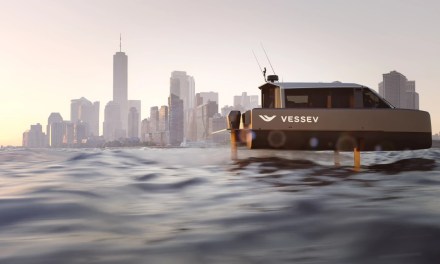Waterloo, ON-based Envgo has joined the growing list of startups developing electric hydrofoils by introducing its first boat called NV1.
The company says its high-performance, sustainable alternative addresses the longstanding experiential and environmental drawbacks of traditional combustion-powered boats that it says have long been associated with pollution, noise, and inefficiency that not only harm the environment but also disrupt the serenity of being on the water.
Envgo tackles these issues by offering a solution that combines clean energy with better performance. The NV1 delivers “an unparalleled boating experience” while minimizing environmental impact by reducing the carbon footprint to zero, focusing on a smooth, quiet, and efficient hydrofoiling design with no emissions or wake.
While many electric solutions on the market suffer from limited range and speed, according to the company, it says its advanced hydrofoil technology and electric propulsion systems overcome these limitations by offering up to a fourfold increase in performance and meeting the demands of the luxury market with a sustainable option.
Envgo was cofounded in 2021 by CEO Mike Peasgood, COO Paul Masojc, CTO Michael Tribou, VP of Engineering Jerry Mailloux, AI Systems Architect April Blaylock, and VP of Business Development Pete Keller. The team’s diverse background, spanning the aerospace, automotive, and marine industries, has enabled it to integrate high-performance propulsion with intelligent autonomous systems, calling on extensive expertise in propulsion systems, hydrodynamics, flight control, and autonomy systems.
The company has secured initial funding from investors who recognize the potential of electrifying the boating industry while eliminating traditional pain points such as noise, wake, pollution, and maintenance. They are not only financially backing the company but also bringing valuable industry connections and business acumen.
The company has partnered with superyacht designer and America’s Cup naval architect David Weiss of Designova Creative to ensure top-tier design and engineering. It is also exploring partnerships with leading technology providers in battery technology, marine engineering, and autonomy systems to enhance the business.
The NV1 luxury cruiser has a carbon-fiber hull, has a mass of 3748 lb (1700 kg) without people, and can fit six passengers including the driver. It is 24.5 ft (8.3 m) long including its swim platform and 8 ft 6 in (2.6 m) wide, with a draft of 2 ft 4 in (0.7 m) when the foils are stowed.
The hydrofoiling capability allows the e-boat to “fly” above the water, drastically reducing drag and increasing efficiency. It is said to not only enhance speed and range but also offer an unmatched smoothness in operation as the boat glides over waves rather than plowing through them. The self-stabilizing avionics make 250 automated foil adjustments per second, with safe foiling enabled by preflight and inflight safety checks.
The NV1’s dual electric motor powertrain produces 125 kW continuous and 245 kW peak power for 25-mph (22-kt) cruise and 50-mph (43-kt) top speeds. The 80-kW·h battery pack allows for a range of up to 80 mi (125 km)—a threefold increase in range compared to conventional e-boats, claims the company. Active battery monitoring aids in accurate range prediction.
The NV1 is engineered to simplify the charging process for a hassle-free experience, integrating with the latest charging infrastructure for flexibility. It can be charged by Level 3 DC and Level 1/2 dockside.
Key NV1 features are a water-skiing sky pylon with retractable water-skiing attachment for tow rope and handle and a 2.0-ft (0.6-m) swim deck. The control interface is by touchscreen, steering wheel, and thumbstick.
The e-boat integrates advanced autonomous features, inspired by the latest automotive technology, to simplify navigation and enhance safety, the latter enabled by redundant sensors.
Pilot assistance includes a night vision camera display and 360 surround view system using six cameras for a top-down view when docking. A collision-avoidance system gets input from radar, the cameras, and underwater sonar.
The Envgo app’s connected features include system health, remote key, music control, light effects, camera stream, navigation plotter, and trip summaries.
Customers can now reserve an NV1 with a fully refundable $1000 deposit to hold a position in the production build, after which a company rep will follow up to discuss exclusive demonstration opportunities, build options, and the delivery schedule.
- Envgo NV1 blue sky render.
- Envgo NV1 low light render.
- Envgo NV1 aero and hydro dynamics for efficiency.
- Envgo NV1 top side view.
- Envgo NV1 rear-facing seats.
- Envgo NV1 test mule.



































































































